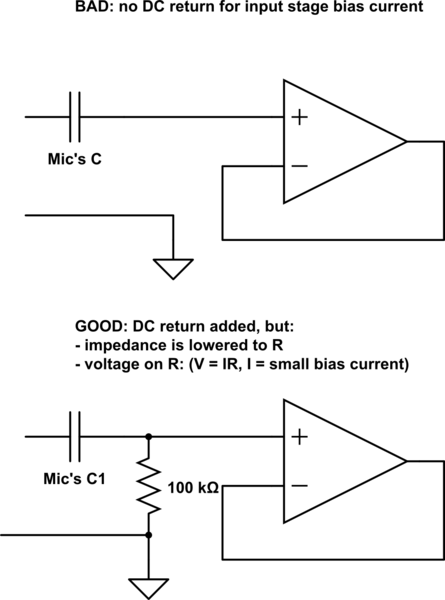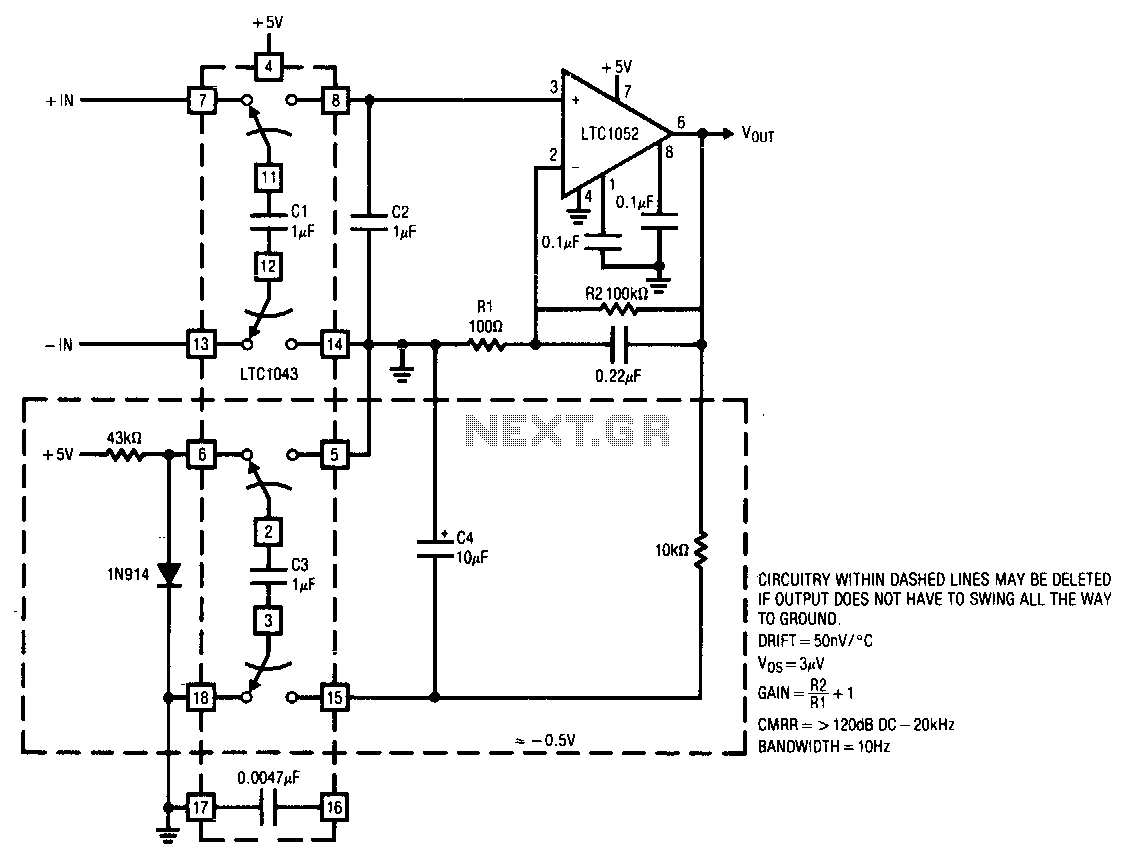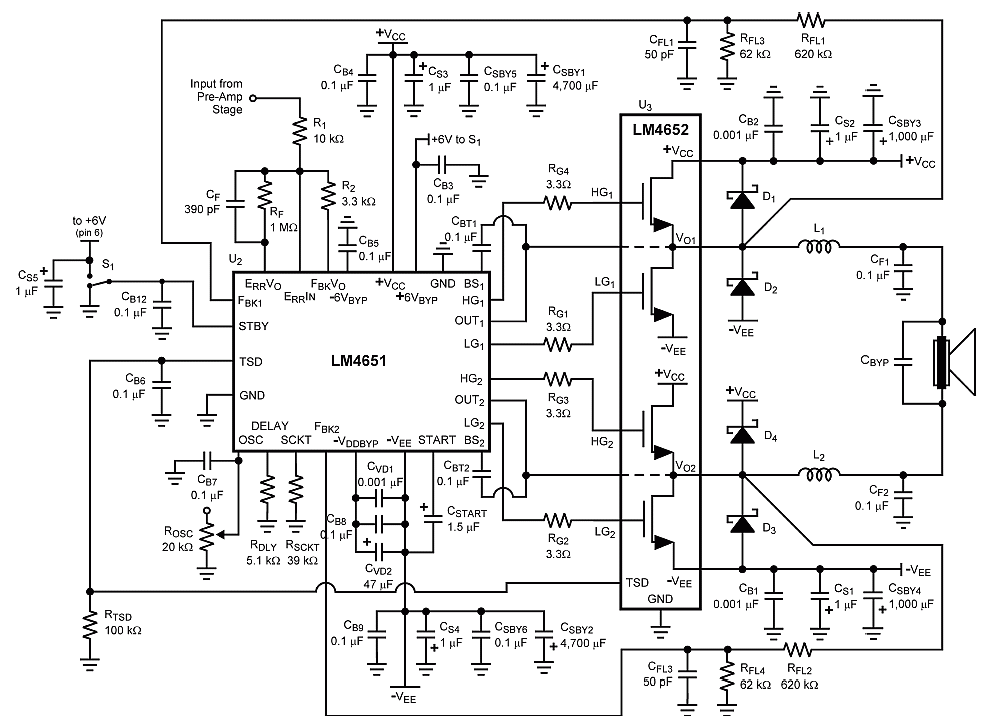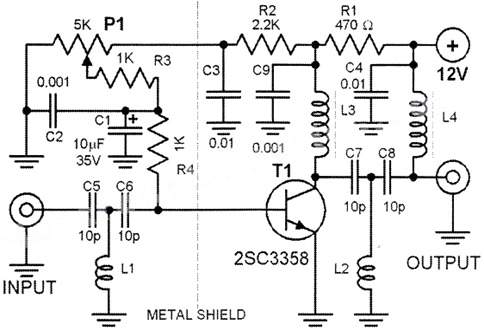
45 Watt Class-B Audio Power Amplifier
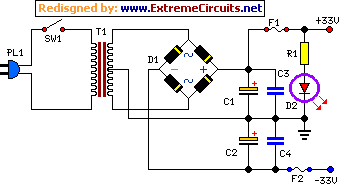
The goals were achieved by utilizing a discrete-components operational amplifier (op-amp) driving a complementary common-emitter output stage configured for Class B operation. In this configuration, for small output currents, the output transistors remain off, allowing the op-amp to supply all output current. At higher output currents, the power transistors become active, limiting the op-amp's contribution to approximately 0.7/R11. The quiescent current of the op-amp biases the external transistors, significantly reducing the crossover range. This concept was inspired by a letter published in Wireless World, December 1982, page 65, authored by N. M. Allinson from the University of Keele, Staffordshire. In this letter, op-amp integrated circuits were proposed as drivers; however, due to the requirement of supply voltages up to ±35V for an amplifier of approximately 50W, the use of a discrete-components op-amp was considered and proved beneficial. The discrete op-amp design is based on a Douglas Self configuration, although his original circuit featured a Class A output stage. To ensure proper operation of this amplifier, the circuit was modified to incorporate a Class B output stage. A mains transformer with a secondary winding rated at the common value of 25 + 25V (or 24 + 24V) and 100/120VA power can drive two amplifiers, achieving outputs of 45W and 69W into 8 and 4 Ohms, respectively, with very low distortion (less than 0.01% @ 1kHz and 20W into 8 Ohms). This straightforward yet robust circuit, designed for high-quality audio applications and as part of a series of articles forming the Modular Preamplifier Control Center, is also well-suited for creating an excellent guitar or bass amplifier.
The described circuit leverages a discrete-components operational amplifier to drive a complementary common-emitter output stage, optimizing performance for audio applications. The Class B configuration is pivotal, as it allows for efficient power handling by ensuring that the output transistors operate only when necessary, thereby minimizing heat generation and improving overall efficiency. The op-amp's ability to provide output current at lower levels ensures that the circuit remains responsive and dynamic, while the engagement of the power transistors at higher output levels enhances the amplifier's capability to deliver significant power without distortion.
The quiescent current of the op-amp is crucial in biasing the external transistors, which facilitates a smoother transition during the crossover region. This design minimizes the audible artifacts typically associated with crossover distortion, a common challenge in amplifier design. The modification from a Class A to a Class B output stage is significant, as it allows for improved thermal performance and efficiency, particularly in high-power applications.
The transformer specifications indicate a robust power supply capable of supporting two amplifiers with substantial output power, making this circuit suitable for various applications, from home audio systems to professional musical instruments. The low distortion figures at specified output levels demonstrate the circuit's fidelity and suitability for high-quality audio reproduction.
In summary, this discrete-components op-amp design presents a versatile solution for audio amplification needs, effectively combining efficiency, power, and sound quality, making it an ideal choice for both high-fidelity audio applications and musical instrument amplification.These goals were achieved by using a discrete-components op-amp driving a BJT complementary common-emitter output stage into Class B operation. In this way, for small output currents, the output transistors are turned off, and the op-amp provides all of the output current.
At higher output currents, the power transistors conduct, and the contribut ion of the op-amp is limited to approximately 0. 7/R11. The quiescent current of the op-amp biases the external transistors, and hence greatly reduces the range of crossover. The idea sprang up from a letter published on Wireless World, December 1982, page 65 written by N. M. Allinson, then at the University of Keele, Staffordshire. In this letter, op-amp ICs were intended as drivers but, as supply voltages up to +/- 35V are required for an amplifier of about 50W, the use of an op-amp made of discrete-components was then considered and the choice proved rewarding.
The discrete-components op-amp is based on a Douglas Self design. Nevertheless, his circuit featured quite obviously a Class A output stage. As for proper operation of this amplifier a Class B output stage op-amp is required, the original circuit was modified accordingly. Using a mains transformer with a secondary winding rated at the common value of 25 + 25V (or 24 + 24V) and 100/120VA power, two amplifiers can be driven at 45W and 69W output power into 8 and 4 Ohms respectively, with very low distortion (less than 0.
01% @ 1kHz and 20W into 8 Ohms). This simple, straightforward but rugged circuit, though intended for any high quality audio application and, above all, to complete the recently started series of articles forming the Modular Preamplifier Control Center, is also well suited to make a very good Guitar or Bass amplifier. Enjoy! 🔗 External reference
The described circuit leverages a discrete-components operational amplifier to drive a complementary common-emitter output stage, optimizing performance for audio applications. The Class B configuration is pivotal, as it allows for efficient power handling by ensuring that the output transistors operate only when necessary, thereby minimizing heat generation and improving overall efficiency. The op-amp's ability to provide output current at lower levels ensures that the circuit remains responsive and dynamic, while the engagement of the power transistors at higher output levels enhances the amplifier's capability to deliver significant power without distortion.
The quiescent current of the op-amp is crucial in biasing the external transistors, which facilitates a smoother transition during the crossover region. This design minimizes the audible artifacts typically associated with crossover distortion, a common challenge in amplifier design. The modification from a Class A to a Class B output stage is significant, as it allows for improved thermal performance and efficiency, particularly in high-power applications.
The transformer specifications indicate a robust power supply capable of supporting two amplifiers with substantial output power, making this circuit suitable for various applications, from home audio systems to professional musical instruments. The low distortion figures at specified output levels demonstrate the circuit's fidelity and suitability for high-quality audio reproduction.
In summary, this discrete-components op-amp design presents a versatile solution for audio amplification needs, effectively combining efficiency, power, and sound quality, making it an ideal choice for both high-fidelity audio applications and musical instrument amplification.These goals were achieved by using a discrete-components op-amp driving a BJT complementary common-emitter output stage into Class B operation. In this way, for small output currents, the output transistors are turned off, and the op-amp provides all of the output current.
At higher output currents, the power transistors conduct, and the contribut ion of the op-amp is limited to approximately 0. 7/R11. The quiescent current of the op-amp biases the external transistors, and hence greatly reduces the range of crossover. The idea sprang up from a letter published on Wireless World, December 1982, page 65 written by N. M. Allinson, then at the University of Keele, Staffordshire. In this letter, op-amp ICs were intended as drivers but, as supply voltages up to +/- 35V are required for an amplifier of about 50W, the use of an op-amp made of discrete-components was then considered and the choice proved rewarding.
The discrete-components op-amp is based on a Douglas Self design. Nevertheless, his circuit featured quite obviously a Class A output stage. As for proper operation of this amplifier a Class B output stage op-amp is required, the original circuit was modified accordingly. Using a mains transformer with a secondary winding rated at the common value of 25 + 25V (or 24 + 24V) and 100/120VA power, two amplifiers can be driven at 45W and 69W output power into 8 and 4 Ohms respectively, with very low distortion (less than 0.
01% @ 1kHz and 20W into 8 Ohms). This simple, straightforward but rugged circuit, though intended for any high quality audio application and, above all, to complete the recently started series of articles forming the Modular Preamplifier Control Center, is also well suited to make a very good Guitar or Bass amplifier. Enjoy! 🔗 External reference
Warning: include(partials/cookie-banner.php): Failed to open stream: Permission denied in /var/www/html/nextgr/view-circuit.php on line 713
Warning: include(): Failed opening 'partials/cookie-banner.php' for inclusion (include_path='.:/usr/share/php') in /var/www/html/nextgr/view-circuit.php on line 713
